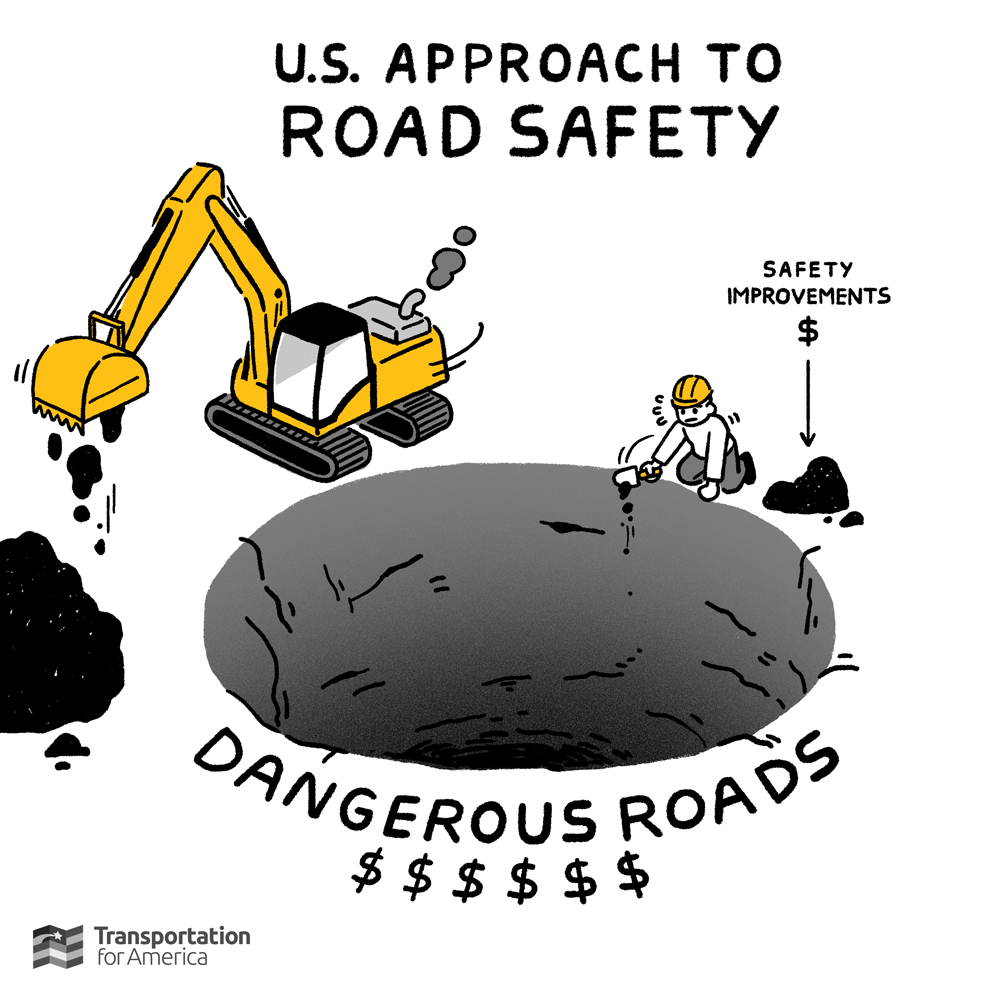Swap in any pressing issue—climate change, repair, safety—and this new illustration by Jean Wei describes the approach to solving it within the much-debated infrastructure bill, which passed on its own late last Friday. You’ll be hearing a lot of unfettered praise for it today, but we’re far more circumspect.

As T4America director Beth Osborne said today,
“[The deal] spends a lot of money but fails to target it to the needs of the day: building strong economic centers, providing equitable access to opportunity, addressing catastrophic climate change, improving safety, or repairing infrastructure in poor condition.”
The bill has a lot of exciting wheelbarrows of new money, but unfortunately it also includes a lot of excavators for the status quo:
- More money for safety? Far more $$ for the status quo approach of more unsafe roads.
- First-ever money for climate in a transportation bill? Historic amounts for new highways that produce more driving & emissions.
- $1 billion to tear down divisive highways? Offset by $300+ billion to build new ones—like Louisiana’s current $750 million plan to bulldoze a Black neighborhood in Shreveport.
- Historic amounts for public transit? Offset by equally historic levels of highway funding that will undermine the transit investments.
This Politico story from Tanya Snyder captures how the bill will fail to move the needle on reducing emissions and addressing climate change, among other issues:
“Congress has cleared a multibillion-dollar infrastructure package that could improve Americans’ commutes and quality of life, but which fails to meet President Joe Biden’s ambitious pledge to cut emissions off at their root: the transportation sector. …Beth Osborne [and T4America]… accused Congress of ‘doubling down on a dinosaur of a federal transportation program’ that she said has produced a dangerous, inequitable and unsustainable transportation network.”
We had a good chance to do something better with the House’s five-year INVEST Act proposal, but the Senate tossed that one aside in favor of making their own inferior five-year proposal the foundation of the larger infrastructure deal.
As Politico notes, this infrastructure bill is completely missing “any requirement that would prioritize repairing things before building new,” which would ensure we actually make progress on repair instead of just spending billions to build new things we can’t afford to maintain. The discarded House bill also would have taken the modest but vital step of requiring states to “measure and reduce their greenhouse gas emissions.”
What’s next?
With the infrastructure deal completed, the Build Back Better budget reconciliation act is still awaiting action. That package does include some important provisions for improving access to transit, grants for reducing emissions, and more. But it’s tough to swallow knowing that the infrastructure deal is likely to make many of these same issues worse, something we wrote about last week:
“We are encouraged to know that Congress is taking seriously the need to address climate change, equity, and economic recovery. But the $40 billion included here unfortunately won’t be enough to redeem the $645 billion-plus infrastructure bill that will continue to make many of those same problems worse. As we’ve said throughout the second half of this year, the administration has a difficult task ahead to advance their stated goals of repair, safety, climate, equity, and access to jobs and services through these small improvements, while spending historic amounts on unchanged programs that have historically made those issues worse.”
Read that post here (updated with info about the approved infrastructure deal) and share our new cartoon above on social media.
We’ve got a lot to say about this new legislation. We’ll be back soon with a detailed rundown of what’s in the infrastructure deal, a look at the highlights, and how we can make the best things possible happen with funding that will soon touch every city and community.
The post Step one for repairing a problem: Stop making it worse appeared first on Transportation For America.











